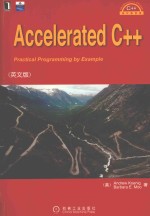
- 作 者:
- 出 版 社:
- 出版年份:2222
- ISBN:
- 标注页数:0 页
- PDF页数:355 页
请阅读订购服务说明与试读!
订购服务说明
1、本站所有的书默认都是PDF格式,该格式图书只能阅读和打印,不能再次编辑。
2、除分上下册或者多册的情况下,一般PDF页数一定要大于标注页数才建议下单购买。【本资源355 ≥0页】
图书下载及付费说明
1、所有的电子图书为PDF格式,支持电脑、手机、平板等各类电子设备阅读;可以任意拷贝文件到不同的阅读设备里进行阅读。
2、电子图书在提交订单后一般半小时内处理完成,最晚48小时内处理完成。(非工作日购买会延迟)
3、所有的电子图书都是原书直接扫描方式制作而成。
Chapter 0 Getting started 1
0.1 Comments 1
0.2 #include 2
0.3 The main function 2
0.4 Curly braces 2
0.5 Using the standard library for output 3
0.6 The return statement 3
0.7 A slightly deeper look 4
0.8 Details 5
Chapter 1 Working with strings 9
1.1 Input 9
1.2 Framing a name 11
1.3 Details 14
Chapter 2 Looping and counting 17
2.1 The problem 17
2.2 Overall structure 18
2.3 Writing an unknown number of rows 18
2.4 Writing a row 22
2.5 The complete framing program 27
2.6 Counting 30
2.7 Details 31
Chapter 3 Working with batches of data 35
3.1 Computing student grades 35
3.2 Using medians instead of averages 41
3.3 Details 48
Chapter 4 Organizing programs and data 51
4.1 Organizing computations 51
4.2 Organizing data 61
4.3 Putting it all together 65
4.4 Partitioning the grading program 68
4.5 The revised grading program 70
4.6 Details 71
Chapter 5 Using sequential containers and analyzing strings 75
5.1 Separating students into categories 75
5.2 Iterators 79
5.3 Using iterators instead of indices 82
5.4 Rethinking our data structure for better performance 84
5.5 The 1 i s t type 85
5.6 Taking strings apart 87
5.7 Testing our split function 90
5.8 Putting strings together 91
5.9 Details 96
Chapter 6 Using library algorithms 101
6.1 Analyzing strings 101
6.2 Comparing grading schemes 110
6.3 Classifying students, revisited 116
6.4 Algorithms, containers, and iterators 120
6.5 Details 121
Chapter 7 Using associative containers 123
7.1 Containers that support efficient look-up 123
7.2 Counting words 124
7.3 Generating a cross-reference table 126
7.4 Generating sentences 129
7.5 A note on performance 136
7.6 Details 137
Chapter 8 Writing generic functions 139
8.1 What is a generic function? 139
8.2 Data-structure independence 143
8.3 Input and output iterators 150
8.4 Using iterators for flexibility 152
8.5 Details 153
Chapter 9 Defining new types 155
9.1 Student_info revisited 155
9.2 Class types 156
9.3 Protection 160
9.4 The Student_info class 163
9.5 Constructors 164
9.6 Using the Student_info class 166
9.7 Details 167
Chapter 10 Managing memory and low-level data structures 169
10.1 Pointers and arrays 169
10.2 String literals revisited 176
10.3 Initializing arrays of character pointers 177
10.4 Arguments to main 179
10.5 Reading and writing files 180
10.6 Three kinds of memory management 182
10.7 Details 185
Chapter 11 Defining abstract data types 187
11.1 The vec class 187
11.2 Implementing the vec class 188
11.3 Copy control 195
11.4 Dynamic Vecs 202
11.5 Flexible memory management 203
11.6 Details 209
Chapter 12 Making class objects act like values 211
12.1 A simple string class 212
12.2 Automatic conversions 213
12.3 Str operations 214
12.4 Some conversions are hazardous 221
12.5 Conversion operators 222
12.6 Conversions and memory management 223
12.7 Details 225
Chapter 13 Using inheritance and dynamic binding 227
13.1 Inheritance 227
13.2 Polymorphism and virtual functions 232
13.3 Using inheritance to solve our problem 237
13.4 A simple handle class 243
13.5 Using the handle class 247
13.6 Subtleties 248
13.7 Details 250
Chapter 14 Managing memory (almost) automatically 253
14.1 Handles that copy their objects 254
14.2 Reference-counted handles 260
14.3 Handles that let you decide when to share data 263
14.4 An improvement on controllable handles 264
14.5 Details 268
Chapter 15 Revisiting character pictures 269
15.1 Design 269
15.2 Implementation 278
15.3 Details 288
Chapter 16 Where do we go from here? 291
16.1 Use the abstractions you have 291
16.2 Learn more 293
Appendix A Language details 295
A.1 Declarations 295
A.2 Types 299
A.3 Expressions 305
A.4 Statements 308
Appendix B Library summary 311
B.1 Input-output 311
B.2 Containers and iterators 314
B.3 Algorithms 322
Index 325
